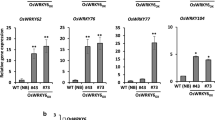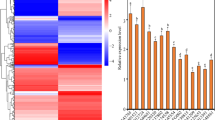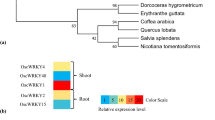Abstract
Key message
OZF1 promotes the transcription of MRD1, which is essential for SA-mediated defense against virulent and avirulent bacterial pathogens in Arabidopsis.
Abstract
Salicylic acid (SA) is critical for defense against biotrophic pathogens. A trans-activator protein NPR1 plays significant roles in SA-signaling. However, evidences suggest the existence of NPR1-independent pathways for SA signaling in plants. Previously, we reported Arabidopsis OXIDATION-RELATED ZN-FINGER PROTEIN1 (OZF1) as a positive regulator of NPR1-independent SA-signaling. However, the mechanism or components of OZF1-mediated SA signaling was not known. Through the analysis of differentially expressing genes, we report the identification of MTO1-RESPONDING DOWN 1 (MRD1) as a transcriptional target of OZF1. Expressions of MRD1 and its overlapping gene in Arabidopsis genome, HEI10 increase upon pathogen inoculation in an OZF1-dependent manner. Their mutants are susceptible to both virulent and avirulent bacterial pathogens and show compromised SA-mediated immunity. Overexpression of MRD1 but not the HEI10 rescues the loss-of-resistance phenotype of the ozf1 mutant. OZF1 physically associates at the MRD1 promoter area upon pathogen inoculation. Results altogether support that MRD1 is a transcriptional target of OZF1 for promoting SA-mediated defense in Arabidopsis.








Similar content being viewed by others
References
Berrocal-Lobo M, Stone S, Yang X, Antico J, Callis J, Ramonell KM, Somerville S (2010) ATL9, a RING zinc finger protein with E3 ubiquitin ligase activity implicated in chitin- and NADPH oxidase-mediated defense responses. PLoS ONE 5:e14426
Bowling SA, Clarke JD, Liu Y, Klessig DF, Dong X (1997) The cpr5 mutant of Arabidopsis expresses both NPR1-dependent and NPR1-independent resistance. Plant Cell 9:1573–1584
Cassandri M, Smirnov A, Novelli F, Pitolli C, Agostini M, Malewicz M, Melino G, Raschella G (2017) Zinc-finger proteins in health and disease. Cell Death Discov 3:17071
Clarke JD, Liu Y, Klessig DF, Dong X (1998) Uncoupling PR gene expression from NPR1 and bacterial resistance: characterization of the dominant Arabidopsis cpr6-1 mutant. Plant Cell 10:557–569
Ding Y, Sun T, Ao K, Peng Y, Zhang Y, Li X, Zhang Y (2018) Opposite roles of salicylic acid receptors NPR1 and NPR3/NPR4 in transcriptional regulation of plant immunity. Cell 173:1454–1467
Dong X (2004) NPR1, all things considered. Curr Opin Plant Biol 7:547–552
Eom KS, Cheong JS, Lee SJ (2016) Structural analyses of zinc finger domains for specific interactions with DNA. J Microbiol Biotechnol 26:2019–2029
Gautam JK, Nandi AK (2018) APD1, the unique member of Arabidopsis AP2 family influences systemic acquired resistance and ethylene-jasmonic acid signaling. Plant Physiol Biochem 133:92–99
Gautam JK, Giri MK, Singh D, Chattopadhyay S, Nandi AK (2021) MYC2 influences salicylic acid biosynthesis and defense against bacterial pathogens in Arabidopsis thaliana. Physiol Plant 173:2248
Giri MK, Singh N, Banday ZZ, Singh V, Ram H, Singh D, Chattopadhyay S, Nandi AK (2017) GBF1 differentially regulates CAT2 and PAD4 transcription to promote pathogen defense in Arabidopsis thaliana. Plant J 91:802–815
Goto DB, Naito S (2002) AtMRD1 and AtMRU1, two novel genes with altered mRNA levels in the methionine over-accumulating mto1-1 mutant of Arabidopsis thaliana. Plant Cell Physiol 43:923–931
Inaba K, Fujiwara T, Hayashi H, Chino M, Komeda Y, Naito S (1994) Isolation of an arabidopsis thaliana mutant, mto1, that overaccumulates soluble methionine (temporal and spatial patterns of soluble methionine accumulation). Plant Physiol 104:881–887
Kusano T, Tateda C, Berberich T, Takahashi Y (2009) Voltage-dependent anion channels: their roles in plant defense and cell death. Plant Cell Rep 28:1301–1308
Mou Z, Fan W, Dong X (2003) Inducers of plant systemic acquired resistance regulate NPR1 function through redox changes. Cell 113:935–944
Nandi A, Welti R, Shah J (2004) The Arabidopsis thaliana dihydroxyacetone phosphate reductase gene SUPPRESSSOR OF FATTY ACID DESATURASE DEFICIENCY1 is required for glycerolipid metabolism and for the activation of systemic acquired resistance. Plant Cell 16:465–477
Nandi A, Moeder W, Kachroo P, Klessig DF, Shah J (2005) Arabidopsis ssi2-conferred susceptibility to Botrytis cinerea is dependent on EDS5 and PAD4. Mol Plant Microbe Interact 18:363–370
Qiu A, Lei Y, Yang S, Wu J, Li J, Bao B, Cai Y, Wang S, Lin J, Wang Y, Shen L, Cai J, Guan D, He S (2018) CaC3H14 encoding a tandem CCCH zinc finger protein is directly targeted by CaWRKY40 and positively regulates the response of pepper to inoculation by Ralstonia solanacearum. Mol Plant Pathol 19:2221–2235
Roy S, Nandi AK (2017) Arabidopsis thaliana methionine sulfoxide reductase B8 influences stress-induced cell death and effector-triggered immunity. Plant Mol Biol 93:109–120
Roy S, Gupta P, Rajabhoj MP, Maruthachalam R, Nandi AK (2018) The polycomb-group repressor MEDEA attenuates pathogen defense. Plant Physiol 177:1728–1742
Saleh A, Alvarez-Venegas R, Avramova Z (2008) An efficient chromatin immunoprecipitation (ChIP) protocol for studying histone modifications in Arabidopsis plants. Nat Protoc 3:1018–1025
Saleh A, Withers J, Mohan R, Marques J, Gu Y, Yan S, Zavaliev R, Nomoto M, Tada Y, Dong X (2015) Posttranslational modifications of the master transcriptional regulator NPR1 enable dynamic but tight control of plant immune responses. Cell Host Microbe 18:169–182
Shah J, Kachroo P, Nandi A, Klessig DF (2001) A recessive mutation in the Arabidopsis SSI2 gene confers SA- and NPR1-independent expression of PR genes and resistance against bacterial and oomycete pathogens. Plant J 25:563–574
Singh N, Swain S, Singh A, Nandi AK (2018) AtOZF1 positively regulates defense against bacterial pathogens and NPR1-independent salicylic acid signaling. Mol Plant Microbe Interact 31:323–333
Swain S, Roy S, Shah J, Van Wees S, Pieterse CM, Nandi AK (2011) Arabidopsis thaliana cdd1 mutant uncouples the constitutive activation of salicylic acid signalling from growth defects. Mol Plant Pathol 12:855–865
Tateda C, Yamashita K, Takahashi F, Kusano T, Takahashi Y (2009) Plant voltage-dependent anion channels are involved in host defense against Pseudomonas cichorii and in Bax-induced cell death. Plant Cell Rep 28:41–51
Varet A, Parker J, Tornero P, Nass N, Nurnberger T, Dangl JL, Scheel D, Lee J (2002) NHL25 and NHL3, two NDR1/HIN1-1ike genes in Arabidopsis thaliana with potential role(s) in plant defense. Mol Plant Microbe Interact 15:608–616
Varet A, Hause B, Hause G, Scheel D, Lee J (2003) The Arabidopsis NHL3 gene encodes a plasma membrane protein and its overexpression correlates with increased resistance to Pseudomonas syringae pv. tomato DC3000. Plant Physiol 132:2023–2033
Vieira Dos Santos C, Cuine S, Rouhier N, Rey P (2005) The Arabidopsis plastidic methionine sulfoxide reductase B proteins. Sequence and activity characteristics, comparison of the expression with plastidic methionine sulfoxide reductase A, and induction by photooxidative stress. Plant Physiol 138:909–922
Withers J, Dong X (2016) Posttranslational modifications of NPR1: a single protein playing multiple roles in plant immunity and physiology. PLoS Pathog 12:e1005707
Wu Y, Zhang D, Chu JY, Boyle P, Wang Y, Brindle ID, De Luca V, Despres C (2012) The Arabidopsis NPR1 protein is a receptor for the plant defense hormone salicylic acid. Cell Rep 1:639–647
Yu Z, Haberer G, Matthes M, Rattei T, Mayer KF, Gierl A, Torres-Ruiz RA (2010) Impact of natural genetic variation on the transcriptome of autotetraploid Arabidopsis thaliana. Proc Natl Acad Sci USA 107:17809–17814
Acknowledgements
Authors acknowledge ABRC, Ohio State University, USA, for mutant seeds, Genotypic Technology, Bangalore, India for microarray analysis, and DST-FISTII of JNU for infrastructural support. A. Singh, and N. Singh Received fellowship from UGC, A. Sharma received fellowship from CSIR.
Funding
This work was primarily supported by the CSIR Grant (38(1515)/21/EMR-II) to AKN.
Author information
Authors and Affiliations
Contributions
AKN conceptualized and designed the experiment. AS, NS, and AS performed the experiments. AS wrote the manuscript, which was further modified by AKN and approved by all authors.
Corresponding author
Ethics declarations
Conflict of interest
The authors have no conflicts of interest to declare.
Additional information
Communicated by Prakash P. Kumar.
Publisher's Note
Springer Nature remains neutral with regard to jurisdictional claims in published maps and institutional affiliations.
Supplementary Information
Below is the link to the electronic supplementary material.
299_2022_2861_MOESM3_ESM.pdf
Supplementary file3 (PDF 6251 KB) Fig. S1: Venn diagram showing the number of the differentially expressed gene after Psm inoculation. Fig. S2: Venn diagram showing the number of differentially expressed genes after PstAvrRpt2 inoculation . Fig. S3: Relative abundance of mRNA of selected DEGs between WT and ozf1 mutants after Psm inoculation. Fig. S4. Relative abundance of mRNA of selected DEGs between WT and ozf1 mutants after PstAvrRpt2 inoculation. Fig. S5 pMRD1:GUS, pHEI10:GUS expression in WT, ozf1 and OZF1-Oex plants after SA or mock treatment. Fig. S6. Relative position of At1g53480(MRD1) and At1g54390(HEI10) genes in the Arabidopsis genome with the position of T-DNA insertions in the mutant lines. Fig. S7. Confirmation of T-DNA insertion lines and plant morphology. Fig. S8. RT-PCR for MRD1 and HEI10 expression in transgenic plants. Supplementary Table S1: List of genes selected for further validation of their expression pattern by qPCR. Supplementary Table S2 : List of primers used in the study
Rights and permissions
About this article
Cite this article
Singh, A., Sharma, A., Singh, N. et al. MTO1-RESPONDING DOWN 1 (MRD1) is a transcriptional target of OZF1 for promoting salicylic acid-mediated defense in Arabidopsis. Plant Cell Rep 41, 1319–1328 (2022). https://doi.org/10.1007/s00299-022-02861-2
Received:
Accepted:
Published:
Issue Date:
DOI: https://doi.org/10.1007/s00299-022-02861-2




